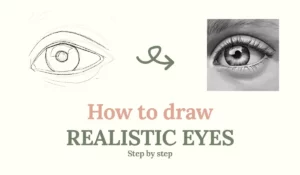In this simple how to draw a realistic rose tutorial we will demystify the complexity of a rose. Drawing flowers can often be daunting, but don’t you worry: if you follow these instructions you’ll be able to draw a rose in a matter of minutes. Let’s start!
How to draw a realistic rose
Analysing the rose
One of the first things we notice about roses is that they’re made out of lots of layers. To make things easier for ourselves we will divide a rose into 3 sections:
1. The centre
2. The middle petals
3. The outer petals


The centre petals are straight and have almost no curve at all. They are very close together, leaving little space in between each one. The further you go outside, the more the edges of each petal curve outwards and downwards. We only have to draw the tips of the inner petals. The ones on the outside show nearly the entire petal.
Also, notice that the edges aren’t straight: they have organic wiggles and imperfections. That’s the trick to make a rose look realistic: make it imperfect.
Start with guidelines
Bounding box & divisions
Let’s start with a rough estimation of where the rose will appear on our canvas. We’re using our bounding box to determine the size of our rose. Since it’s just a guideline, our rose can have petals that go slightly inside or outside our bounding box. Don’t be too precise, we’re still sketching!
1. Draw the bounding box. Mine is roundish. If our rose would be viewed from the front the bounding box would be box shaped.
2. Next, we’re going to draw a line straight through the centre of our rose. The angle of our line depends on which way our rose is facing. Ours is going to face the upper left.


3. Now we divide our bounding box into 6 sections. Each section will contain a layer of petals. We curve the lines because they wrap around our centre line.
Adding the petals


1. Let’s draw the petals. The petals should go in each section. Don’t go over or under it, they sit inside it.
2. Add the second layer of petals. Remember that the petals curve around the centre.


3. To keep things clear we now add (a part of) the centre. The tops of the petals should touch the edges of the central division.
4. Let’s add the 3rd division petals. Notice that this division has a lot of room: there’s enough space for 2 layers. Let’s start with the layer that’s on the inside. We only draw the tips, the bottom part of the petals will be cover by the layer beneath it.


5. Now we add the 2nd layer of petals in the 3rd division. We also add the inner part of the centre.
6. Now we fill up any leftover space. Mimic other petals for a cohesive result: remember, the ones close to the centre are straighter.


7. Now we refine and darken each petal. We add some wiggles and curves. Some of the petals have tips that curl over.
8. Notice that I changed some things before step 7: I split the petal on the outer right into 2 petals, and I gave more definition to the centre petals. I also added some petals to the outsides to give it a round shape. Add petals to your liking!
Stem


1. Next we add 2 ovals on our centre line.
2. We connect the ovals to our rose by drawing the stem. The stem gets thicker toward each oval. Kinda like bamboo.
Shading the rose petals and stem
The rose looks very complicated because we haven’t added any shadows yet. In this case, I used the hatching method.


1. I darkened the areas that are close to each other and where there’s very little space. Like the centre.
2. Now I add some shadows at the edges of the petals. Now it looks like they aren’t that flat anymore.


3. I added a thin hatching layer all over the rose. It’s barely visible but I think it ties everything together!
4. We do the exact same for the stem. A very light layer all over it. Then, we darken the area near the edges to give the illusion its round. The rose casts a shadow on the stem as well, so we darken that area.
Optional: leaf


1. We start with the bounding box. We indicate which direction the leaf should go, and where it sits on the stem.
2. We slightly refine it. We add a centre line, and then refine the tip.


3. We erase the sketch lines and darken our final lines.
4. Now we add values to make it appear like the leaf is curved. The tip curls at the end, so we darken the bottom part.
Final result

Challenge
Want to see if you can apply these steps to any rose you want?
Draw this rose using the method you just learned.

Remember: bounding box, centre line, divisions.. You got this!
Use #Oleandered on Instagram for a chance to be featured on my stories. I’d love to see your work!
I hope you enjoyed this rose drawing tutorial. See you next tutorial!
♡ Laura




